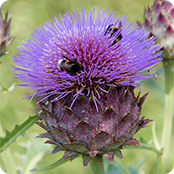Perennials have ways of tolerating extreme weather
Weather conditions are becoming increasingly extreme.

We’re being confronted with longer periods of drought, higher average temperatures and more precipitation peaks. Perennials have ways to deal with our changing climate.
A water-retentive capacity
Precipitation peaks are increasing in both frequency and intensity. Plants – including perennials – absorb part of this precipitation and release it into the soil. Since this rainwater can soak into the soil more easily, puddles form more slowly and storm sewers can handle runoff volumes better. Perennials also transpire water: the larger the leaf surface, the more transpiration takes place.
Drought
Experts are predicting more drought, especially in the summer. Perennials such as Hardy Jerusalem Sage ( Phlomis), Rudbeckia and Catmint ( Nepeta) can easily withstand this drought, and so can certain species of ornamental grasses such as: Japanese Sedge ( Carex morrowii) and another sedge known only by its scientific name, Carex foliosissima.
Heat island effect
When the average temperature in an urban area is higher than the average temperature in its surrounding rural area, this is referred to as a “heat island effect”, and this phenomenon is happening more often these days. But certain methods, including the use of perennials, can reduce this effect; the more plants there are, the lower the surrounding temperature is.
Soil moisture content
Almost no location in public space is only wet or dry all year round. Many perennials, however, can tolerate major fluctuations in soil moisture content. Among these, Purple Loosestrife ( Lythrum salicaria) is one of the best. It can be submerged in water for months at a time but still tolerate drought.
Tips
- Planting perennials under tree canopies can prevent the soil around street trees from slaking and eroding.
- Many perennial species are suitable for planting in ephemeral swales where rainwater collects and infiltrates into the soil. These water-buffering facilities improve both infiltration capacity and water purification. Using perennials for this purpose provides a high ornamental value and contributes to biodiversity.
- At locations providing little space, combine the use of plants with underground buffering measures such as storage tanks and stormwater crates.
- About Perennial Power
Perennial Power, the promotional organisation for the perennial plant sector, uses international PR to promote the use of perennials.

- The PR team
Ineke van Kesteren
Anne Verdoes
Jessica Ruitenberg-Wagemaker
